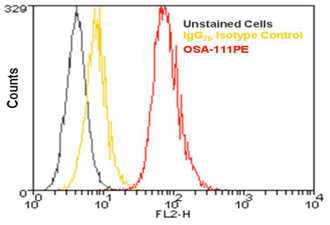Product Details
| Alternative Name: | HMOX1, Hsp32, Heat shock protein 32, Heme oxygenase 1 |
| |
| Clone: | HO-1-2 |
| |
| Host: | Mouse |
| |
| Isotype: | IgG2b |
| |
| Immunogen: | Native rat HO-1. |
| |
| UniProt ID: | P06762 |
| |
| GenBank ID: | J02722 |
| |
| Source: | Purified from ascites. |
| |
| Species reactivity: | Human, Mouse, Rat
Dog, Guinea pig, Hamster, Monkey, Porcine, Rabbit
|
| |
| Applications: | Flow Cytometry
|
| |
| Recommended Dilutions/Conditions: | Flow Cytometry (1:100)
Suggested dilutions/conditions may not be available for all applications.
Optimal conditions must be determined individually for each application. |
| |
| Purity Detail: | Protein G affinity purified. |
| |
| Formulation: | Liquid. In PBS containing 0.09% sodium azide. |
| |
| Shipping: | Blue Ice Not Frozen |
| |
| Long Term Storage: | +4°C |
| |
| Scientific Background: | Heme Oxygenase-1 (HO-1) also known as Hsp32, is the inducible isoform of heme oxygenase that catalyzes the NADPH, oxygen, and cytochrome P450 reductase dependent oxidation of heme to carbon monoxide, ferrous iron and biliverdin which is rapidly reduced to bilirubin. These products of the HO reaction have important physiological effects: carbon monoxide is a potent vasodilator and has been implicated to be a physiological regulator of cGMP and vascular tone; biliverdin and its product bilirubin are potent antioxidants; "free" iron increases oxidative stress and regulates the expression of many mRNAs (e.g., DCT-1, ferritin and transferring receptor) by affecting the conformation of iron regulatory protein (IRP)-1 and its binding to iron regulatory elements (IREs) in the 5'- or 3'- UTRs of the mRNAs. To date, three identified heme oxygenase isoforms are part of the HO system that catalyze heme into biliverdin and carbon monoxide. These are inducible HO-1 or Hsp32, constitutive HO-2 that is abundant in the brain and testis, and HO-3 which is related to HO-2 but is the product of a different gene. The HO system is the rate-limiting step in heme degradation and HO activity decreases the levels of heme which is a well known potent catalyst of lipid peroxidation and oxygen radical formation. |
| |
| Regulatory Status: | RUO - Research Use Only |
| |

Flow cytometry analysis of 106 Jurkat cells were stained using HO-1 (HSP32) mAb (HO-1-2), R-Phycoerythrin Conjugate at a concentration of 10µg/ml.
Please mouse over
Product Literature References
Heme catabolism by tumor-associated macrophages controls metastasis formation: F.M. Consonni, et al.; Nat. Immunol.
22, 595 (2021),
Abstract;
Effect of Culture at Low Oxygen Tension on the Expression of Heat Shock Proteins in a Panel of Melanoma Cell Lines: C. Shipp, et al.; PLoS One
7, e37475 (2012),
Application(s): Flow Cytometry,
Abstract;
Full Text
Immune-related antigens, surface molecules and regulatory factors in human-derived mesenchymal stromal cells: the expression and impact of inflammatory priming: M. Najar, et al.; Stem Cell Rev.
8, 1188 (2012),
Abstract;
General Literature References
Transforming Growth Factor-β, Macrophage Colony-Stimulating Factor and C-Reactive Protein Levels Correlate with CD14highCD16+ Monocyte Induction and Activation in Trauma Patients: S.D. West, et al.; PLoS One
7, e52406 (2012),
Application(s): Flow Cytometry,
Abstract;
Full Text












